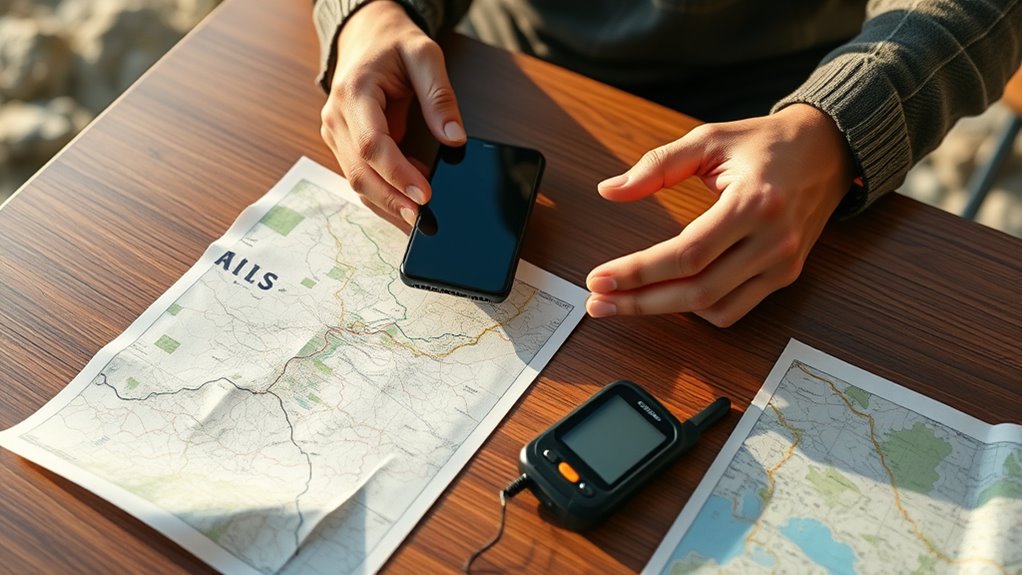To set up offline maps before departure, choose a reliable map app with good reviews and easy navigation. Prepare your device by freeing storage space, updating software, and downloading only the maps you need for your trip. Organize your files for quick access and verify maps are complete and up-to-date. Test them offline to guarantee everything works smoothly. Staying prepared helps you avoid issues during your trip and enhances your navigation experience. More tips can help you master the process.
Key Takeaways
- Choose a reliable offline map app with detailed features and positive user reviews.
- Verify sufficient device storage and organize maps into folders for easy access.
- Download only necessary map layers for planned routes and points of interest.
- Update maps and app software regularly; perform backups on cloud or external drives.
- Test offline maps offline by navigating key locations to ensure accuracy before departure.
Choosing the Right Offline Map App
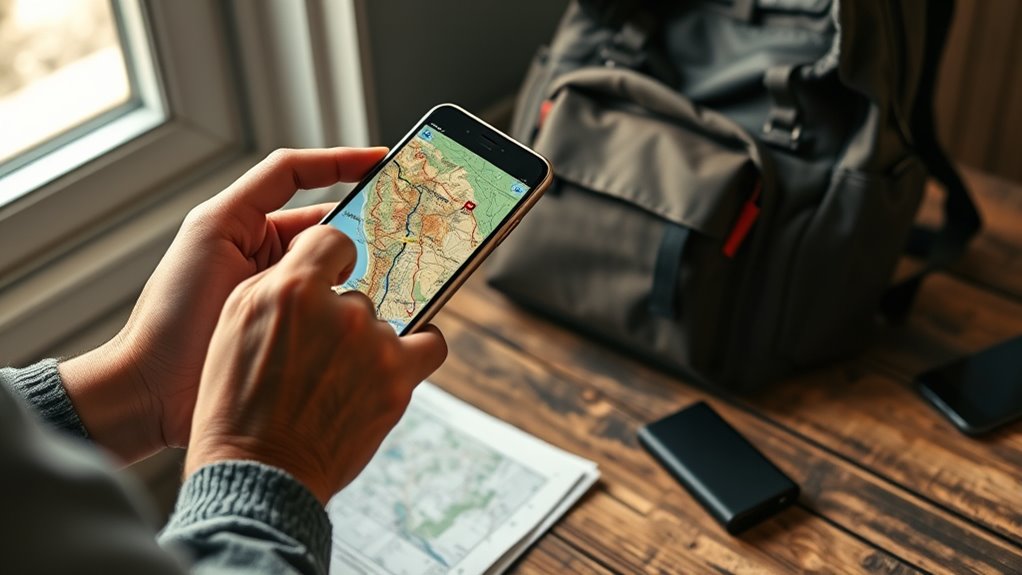
Choosing the right offline map app is essential for ensuring you have reliable navigation when you’re off the grid. You need an app with robust map app features, like detailed offline maps, route planning, and easy search options. Look for an app with a user interface design that’s intuitive and simple to navigate, especially when you’re in unfamiliar territory. A clear layout and easy access to key functions can make your experience smoother and less stressful. Avoid apps with cluttered screens or complicated menus, as they can slow you down when you need quick directions. Consider reviews and user ratings to gauge reliability and ease of use. Mastering time zones and understanding your local time context can also enhance your trip planning and coordination. Selecting an app that offers comprehensive water park maps can help you navigate large resort areas more efficiently, saving you time and enhancing your experience. Incorporating AI-powered navigation features can further improve accuracy and provide real-time updates, making your navigation even more dependable. Choosing an app with reliable offline data ensures you won’t be left stranded without directions in areas with poor connectivity, which is crucial for a stress-free trip. Picking an app that balances powerful features with a straightforward user interface helps you stay confident and prepared during your trip.
Preparing Your Device for Offline Maps

Before you start downloading offline maps, make sure you have enough storage space on your device. Check your settings to verify available memory and delete any unnecessary files if needed. This way, you’ll ensure a smooth download process without running into space issues. Additionally, being aware of storage management can help optimize your device’s performance for future downloads. Ensuring your device is optimized for performance can also prevent interruptions during the download process. Keeping your device up-to-date with software updates can further enhance stability during the process, especially when managing filter replacement indicators or other maintenance features that keep your device functioning smoothly. Regularly monitoring your device’s storage capacity helps avoid unexpected issues during map downloads.
Download Necessary Map Data
To guarantee you have access to maps even without an internet connection, you need to download the necessary map data onto your device before departure. Focus on selecting the specific map layering you’ll need, such as city streets, topography, or landmarks, to keep your offline maps detailed and useful. Ensuring offline data security is essential—only download from trusted sources and keep your device’s security settings updated. Additionally, essential oils for protection can be used to create a calming environment during your preparations, reducing stress and enhancing focus. Utilizing sound healing science techniques like calming sound frequencies can further improve your focus and relaxation during setup. Moreover, choosing reliable map apps with positive user reviews can help you avoid potential issues during your trip. By doing this, you prevent unauthorized access to your offline maps and protect your device from potential threats. Color accuracy also plays a vital role in ensuring that the visual information displayed on your maps remains clear and true to life. Carefully choose the areas you’ll visit most, and download their map data in advance. This proactive step guarantees seamless navigation during your trip, even in remote locations with limited or no connectivity, especially as smart device security practices evolve.
Verify Storage Space
Ensuring your device has enough storage space is essential before downloading offline maps, as insufficient space can prevent successful downloads and hinder navigation. Start with a quick storage check to determine available space. If needed, manage your storage by deleting unused apps, photos, or files to free up room. Proper space management guarantees smooth downloads and ideal map performance. Additionally, understanding storage optimization techniques can further improve your device’s capacity for multiple downloads and app performance. Being aware of the importance of using renewable resources can help you make eco-conscious choices when managing your device’s storage and applications.
Selecting Your Destination Areas for Download
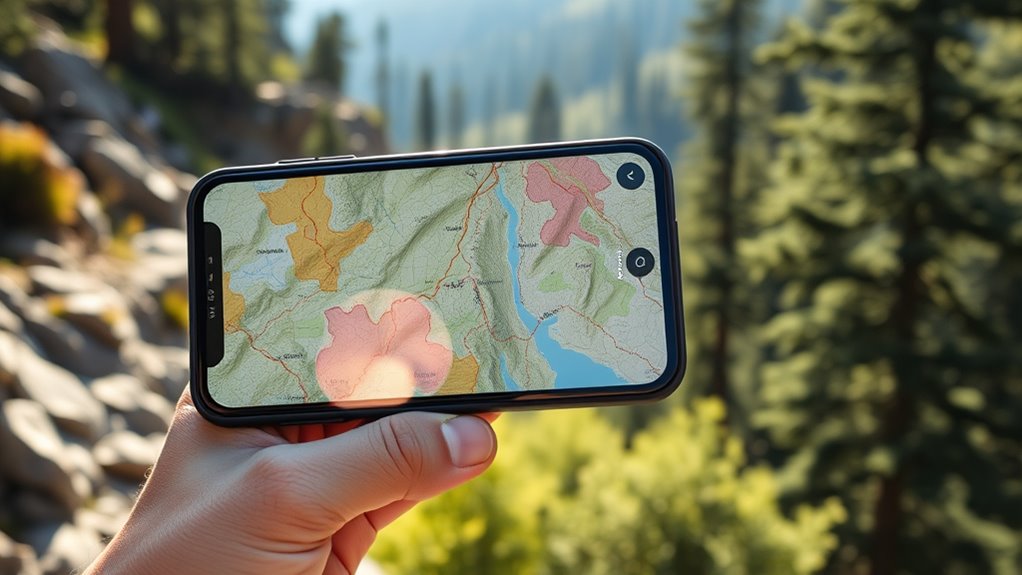
Choosing the right destination areas to download is essential for a smooth offline map experience. Your destination selection should focus on areas you’ll visit or need detailed navigation within, guaranteeing you won’t miss critical routes or landmarks. Consider the map coverage needed for your trip—select regions that encompass your planned routes and key points of interest. Avoid downloading excessive areas that you won’t access, as this can fill up storage unnecessarily. Use your mapping app’s planning tools to pinpoint the exact regions to download, balancing comprehensive coverage with storage limits. Additionally, understanding the importance of accurate map data helps ensure your navigation remains reliable throughout your journey. Being aware of up-to-date information can significantly improve your overall navigation experience, especially in unfamiliar areas. To enhance your trip planning, consider local landmarks and regional features to ensure all critical locations are covered. Recognizing the impact of wind turbine blade weight on transportation logistics can also help in planning access routes for larger download areas. Moreover, understanding Gold IRA options and their associated risks can be beneficial if you are considering diversifying your investments during your travels. By carefully selecting your destination areas, you guarantee reliable navigation without wasting space, making your offline map setup efficient and tailored to your travel plans.
Downloading Maps for Offline Use
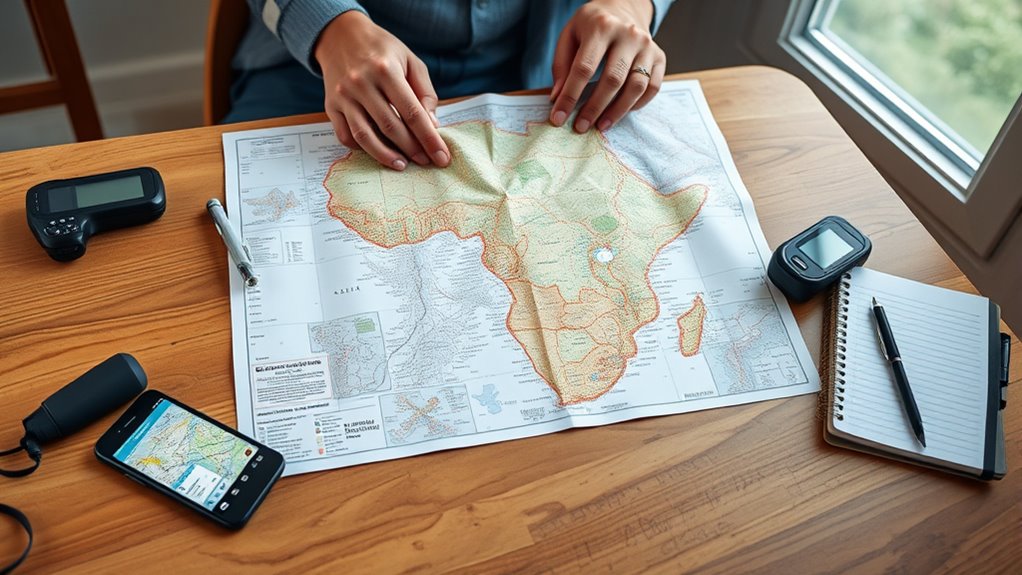
Once you’ve selected the areas to download, the next step is to initiate the download process within your mapping app. This often involves tapping a “Download” button or selecting an option in the user interface. To guarantee your maps are useful, consider map customization options, such as choosing specific zoom levels or detail layers. Keep in mind, a clear and simple user interface makes this process smoother. Additionally, understanding Kia Tuning options can help you optimize your vehicle’s performance for better navigation and driving experience.
Organizing and Managing Your Offline Maps

To make the most of your offline maps, you need to choose only the essential ones for your trip. Organize your files so you can find what you need quickly, and keep everything tidy. Remember to regularly update your maps and back up your files to avoid any surprises during your journey.
Selecting Essential Maps
How do you decide which maps are truly essential for your trip? Start by considering your itinerary and activities. Focus on areas you’ll visit frequently or need quick access to, rather than downloading entire regions. Map customization helps you select only the necessary sections, saving storage space. Your user preferences also matter—prioritize maps that suit your navigation style, whether detailed street views or broader regional overviews. Avoid cluttering your device with unnecessary data by removing maps you won’t use. Think about the trip’s key locations, landmarks, and routes. This targeted approach ensures you have the right offline maps ready when needed, without overwhelming your device or cluttering your interface. Selecting essential maps tailored to your plans makes navigation smoother and more efficient.
Organizing Files Efficiently
Are you making the most of your offline maps by keeping your files organized? Proper folder organization and consistent file naming help you quickly find maps when needed. Start by creating folders for different regions or countries, and within those, separate maps by city or area. Use clear, descriptive file names that include location and date, so you can easily identify the latest versions. Regularly review your files and delete outdated maps to save space. Establish a logical hierarchy that makes sense to you, avoiding clutter and confusion. Keeping your offline maps organized ensures smooth navigation without wasting time searching. With well-structured folder organization and thoughtful file naming, your map library remains efficient and accessible. This approach saves time and reduces frustration during your travels.
Updating and Backup
Regularly updating your offline maps ensures you have the most accurate and current information, which is essential for smooth navigation. Staying current minimizes errors and enhances map data security. Implement backup strategies to protect your data from loss or corruption. Store copies in multiple locations, such as cloud storage or external drives, to guarantee accessibility. Consistent updates also help you identify outdated map files, reducing confusion.
| Update Frequency | Backup Location | Map Data Security |
|---|---|---|
| Weekly | Cloud Storage | Encryption |
| Monthly | External Drive | Password Protection |
| After Major Changes | USB Drive | Regular Security Checks |
| Before Departure | Local Device Backup | Data Integrity Checks |
This approach keeps your offline maps reliable and safe, ensuring seamless navigation wherever you go.
Testing Your Offline Maps Before Departure
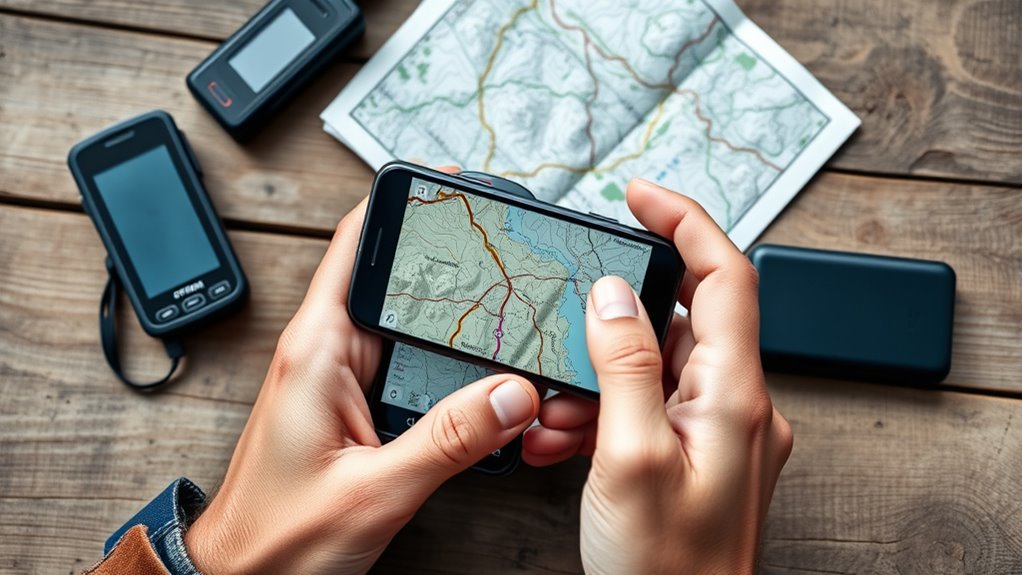
Before you set out on your trip, it’s vital to test your offline maps to make sure they function correctly. This step guarantees the maps are accurate, customized to your preferences, and secure offline. Testing helps identify issues with map customization, such as incorrect routes or missing details. It also verifies offline map security, preventing data breaches or accidental deletions during your journey.
Always test your offline maps before traveling to ensure accuracy, security, and proper customization.
- Open your offline map app and navigate to key locations to confirm accuracy
- Check map details, labels, and landmarks for proper display
- Test route planning to ensure it works offline
- Review map customization settings for preferences
- Confirm offline map security by verifying data protection measures
Tips for Navigating With Offline Maps

When exploring with offline maps, staying attentive to your surroundings is essential since you won’t have real-time updates. To make navigation smoother, customize your offline map settings to highlight key routes or landmarks, which helps you stay oriented. Use offline map customization features to add preferred labels or route preferences, making navigation more intuitive. Keep battery optimization in mind; disable unnecessary app functions like background refresh or location services when not needed. Lower screen brightness and switch to power-saving modes if possible. Regularly check your device’s battery level before heading out, ensuring your offline maps remain functional throughout your journey. These tips help you navigate confidently, conserve battery life, and stay focused on your surroundings without relying on internet connectivity.
Updating Offline Maps Regularly
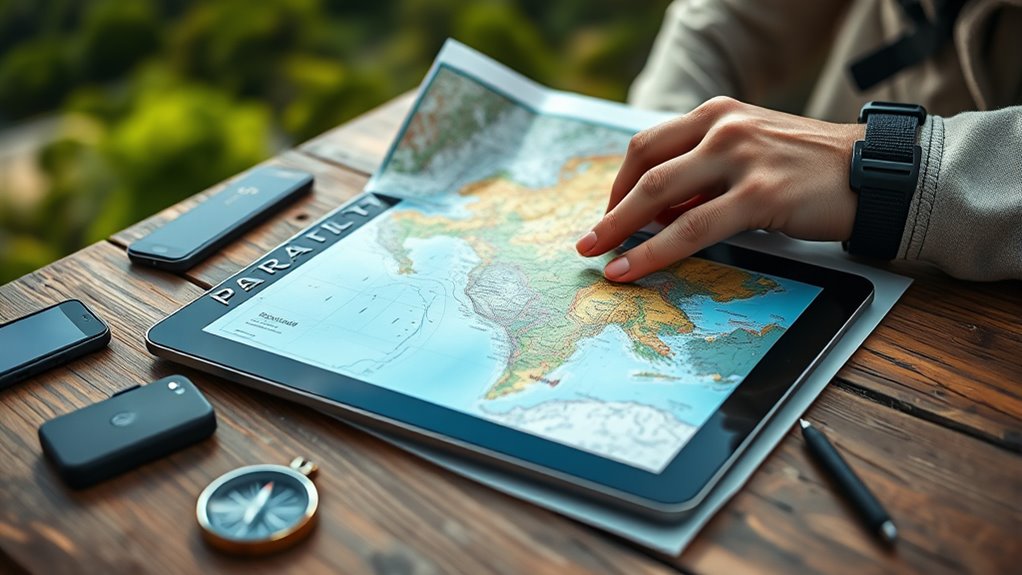
To guarantee your offline maps stay reliable, you need to schedule regular updates and verify their accuracy. Setting reminders helps you keep maps current, especially when traveling to new areas. Keeping your maps up-to-date minimizes surprises and keeps navigation smooth.
Schedule Map Updates
Regularly scheduling map updates guarantees your offline maps stay accurate and reliable. To do this effectively, establish a clear map update schedule based on your travel plans and data needs. Decide on an offline update frequency that suits your usage—whether weekly, biweekly, or monthly. Consistency ensures you won’t miss important changes or new routes. Keep track of when your last update was performed to maintain current maps. Automate updates if possible to avoid forgetting. Regular updates help prevent navigation errors and improve overall reliability. Remember, a well-planned offline update frequency minimizes surprises during trips.
- Set reminders for scheduled updates
- Check for new map versions periodically
- Adjust update frequency based on destination changes
- Use auto-update features when available
- Keep enough storage for new data
Verify Map Accuracy
How can you guarantee your offline maps remain accurate and reliable? Regularly verifying map accuracy is essential. Check the map detail to ensure landmarks, roads, and points of interest are current. Outdated maps can compromise route accuracy, leading to wrong turns or missed destinations. Before your trip, compare your offline map with recent online sources or local updates. Look for changes like new roads, closures, or altered routes. If discrepancies exist, update the map accordingly. Keeping your offline maps current ensures you maintain route accuracy, avoiding navigation errors. By staying vigilant and verifying the map’s detail before departure, you reduce the risk of surprises on the road, making your journey smoother and more reliable.
Troubleshooting Common Offline Map Issues

Offline map issues can be frustrating, but many problems have simple solutions. If your maps aren’t loading correctly or aren’t displaying as expected, start by checking your device’s map customization settings. Sometimes, incorrect preferences can affect map display. Make sure your app’s user interface is not cluttered or confusing, which can cause navigation problems. Clear cache or update the app if maps are outdated or glitchy. Confirm that your offline maps are fully downloaded and not corrupted. If issues persist, try restarting your device or reinstalling the app. Adjusting download settings or toggling offline mode can also resolve glitches.
Check your offline maps are fully downloaded and not corrupted to fix display issues.
- Verify map customization settings
- Refresh or reinstall the app
- Check for app updates
- Confirm offline map downloads
- Restart your device
Ensuring Your Device Is Ready for Offline Navigation
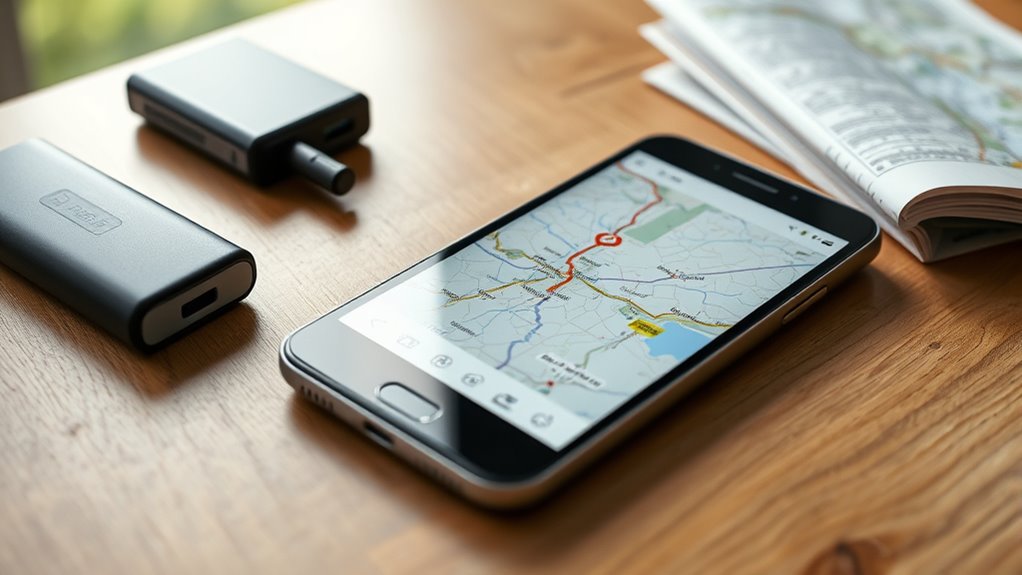
Before heading out on your trip, make sure your device is fully prepared for offline navigation. Start by checking device compatibility to ensure your phone or tablet supports the navigation app and offline map features. Update your device’s operating system and the app itself to prevent compatibility issues. Next, customize your offline map by selecting the specific regions or routes you’ll need, avoiding unnecessary data storage. Confirm that your device has enough storage space for the offline maps and that your battery is sufficiently charged or you have a portable charger. These steps help prevent app crashes or map errors during your trip. By verifying device compatibility and customizing offline maps, you ensure a smooth, hassle-free navigation experience without relying on an internet connection.
Frequently Asked Questions
How Much Storage Space Do Offline Maps Typically Require?
Offline maps usually need between 100MB and 1GB of storage space, depending on the area and level of detail. Storage considerations are important because larger map file sizes cover more extensive regions or offer higher resolution. You should check your device’s available space and select map areas wisely to avoid running out of storage. Smaller, specific regions take up less space, making them a practical choice for most users.
Can I Use Offline Maps on Multiple Devices Simultaneously?
Imagine you’re planning a trip with friends, and everyone wants offline maps. You can use maps on multiple devices, but it hinges on your app’s device synchronization and map sharing options. Some apps allow you to sync maps across devices with a single account, while others require downloading separately. Check your app’s settings to guarantee seamless offline map access on all your devices during your journey.
Do Offline Maps Include Real-Time Traffic Updates?
Offline maps don’t include real-time traffic updates because they rely on stored data. Instead, they have a limited map refresh frequency, meaning the maps are static until you update them. If you want real-time traffic updates, you need an online connection. Without internet, offline maps can’t provide live traffic info, so plan your routes accordingly and refresh your maps regularly for the latest data before your trip.
How Long Do Offline Maps Stay Valid Without Updates?
Imagine relying on your offline map, only to find it outdated when you need it most. Offline map longevity varies, but without recent map updates, it could become unreliable within a few weeks or months. The map update frequency directly impacts how long your offline maps stay accurate. Stay vigilant—regular updates guarantee your offline maps remain helpful, offering peace of mind during your adventures, no matter how long your trip lasts.
Are Offline Maps Available for All Countries and Regions?
You might wonder if offline maps are available everywhere. Availability depends on the map update frequency and offline map compatibility, which vary by country and region. While major cities and popular destinations often have detailed offline maps, some remote areas may have limited coverage. Check your app’s map update frequency to guarantee you get the latest data, and verify offline map compatibility for your destination before traveling.
Conclusion
By preparing your offline maps thoroughly, you’re arming yourself with a navigation tool that’s more reliable than your morning coffee. With the right app, organized downloads, and regular updates, you’ll navigate unfamiliar territories smoothly and confidently—without ever risking a dead zone or getting lost in the digital wilderness. Master these steps, and you’ll have a navigation system so dependable, it’s practically your personal GPS superhero. Safe travels!
